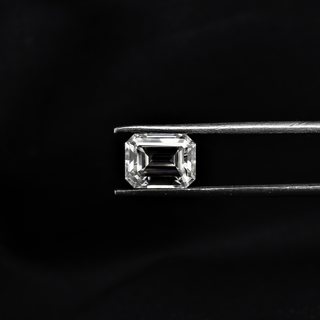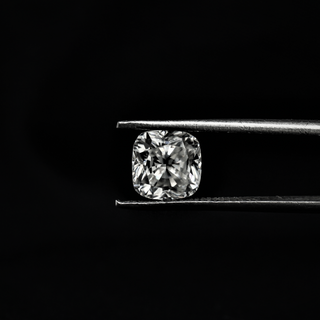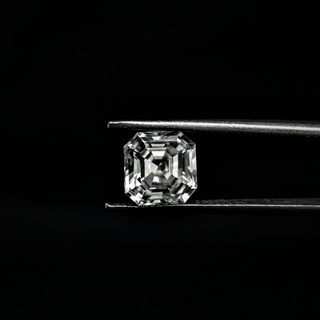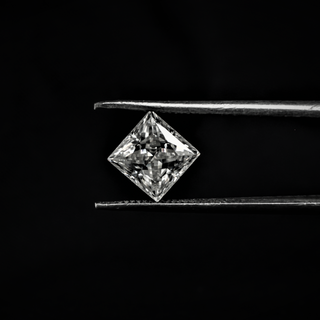Moissanite Has A Tremendous History, full of scientific wonders, Innovation, And Evolution, which began with dust and evolved into a spark. It is More Than Just a Beautiful Stone, which started its Journey from the hands of a famous scientist, Henri, to market gemstones from a natural Meteorite Crater to a lab-grown stone.
Today, We Will Help You Discover Everything about the History Of Moissanite And Its Rise In The Jewelry World. Come, Let Us Begin!
First Discovery Of Moissanite

Moissanite Was indeed Born From The Stars because its rarity is its answer. It Was First Discovered By A Famous Scientist In 1893, French Chemist Henri Moissan. At That Time, When He Was Examining Some Rock Samples, He Found Something That Sparkled From An Angle In An Area Of Canyon Diablo, Arizona. He Initially Thought Maybe It’s A Diamond due to its incredible Sparkle, But When He keenly observed he Believed That This Dazzling Crystal Wasn't A Diamond, and then he again analyzed it carefully, and After A While He Identified It As A Completely Different Mineral Composed Of Silicon Carbide which was Never Seen Before. That Is Why, In Honor Of Henri Moissan, The Mineral Was Named as Moissanite.
Origin of Moissanite

Yes! Natural Moissanite Is Rare Due To Its Natural Occurrence. The Origin Of Moissanite Is Formed Under Extreme Temperatures And Pressures, Which Makes It Almost an Nonexistent Stone On Earth. Besides Meteorites, Moissanite Has Been Found In Some Upper Mantle Rock, Because Of Its Exceptional Rarity And Insufficient Supply. Nowadays, The Moissanite, jewelers Are Using man-made Moissanite Created In Laboratories for their pieces of jewelry.
Lab Creation of Moissanite

No doubt, Moissanite Was Discovered Over 100 Years Ago but The Process To make it more convenient to reach Was Discovered Very late Because At That Time There Were No Such Technologies and Laboratories Which Are Used Nowadays, It Wasn't Until The 1990s That The Process To Create Moissanite In A Laboratory With Perfection Was Confirmed. Do You Know It Was 1990 When The First Moissanite Became Available?
Moissanite’s 20th Century Breakthrough
In The Late 20th Century, Many Scientists Found Out A Few Techniques That Helped Them In The Development Of Some Methods, Which Were Very Beneficial For The Environment, As These Methods Were Used Accordingly To Create Silicon Carbide Crystals In Laboratories And Introduced Moissanite Worldwide. This Breakthrough In The 20s Made It Possible To Produce Moissanite In A Controlled Environment Without Any Destruction Or Mining. Thanks To Years Of Research And Technological Advancement
Rising Popularity Of Moissanite
The First Company, Which Introduced This Dazzling Gem To The World As A Beautiful And Affordable Alternative To Natural Diamonds, Was Charles & Colvard Company; They Man-Made The Moissanite And Introduced It Globally As Lab-Created Moissanite or synthetic gems, Allowing Its Big Entry As A Magical Gem.
A Sparkling Alternative To Diamonds
Due To The Extreme Sparkle And The Overall Brilliance Of Moissanite, When Moissanite Was Introduced To The Jewelry Market, It Was Quickly Compared To Diamonds. Because Moissanite Offers Several Advantages Over Diamonds. Not Only For Its Brilliance, But Also Because Of Its Hardness And Affordability.
-
Moissanite Is More Affordable Than Diamonds, Allowing You To Choose Larger Or Higher-Quality Stones For Less Price.
-
Moissanite Has Greater Brilliance Due To Its Higher Refractive Index, Resulting In More Sparkle.
-
Moissanite Ranks 9.25 On The Mohs Scale Of Hardness, Next To Diamond, Which Scores A Full 10 On 10.
-
Moissanite Is An Eco-Friendly And Ethically Sourced Gem, While Diamonds Often Raise Environmental And Ethical Concerns.
These Benefits Made Moissanite A Popular Choice For Fine Jewelry And Especially For Engagement Rings, Anniversary Gifts, And Fashion-Forward Consumers Who Are Looking For Ethical, Affordable Alternatives.
Moissanite Technologically Advancement
Moissanite Has Everything From Modernity, Popularity, To Design Versatility. Today, Moissanite Is Featured In A Wide Array Of Fine Jewelry, From Solitaire Engagement Rings To Bold Bracelets, Pretty Pendants, And Stunning Earrings, And More. Whether You Are A Fan Of Bold Fashion pieces or A Simple Style, Moissanite can fulfill your wishes.
Evolution of Moissanite
Buyers And Designers Love Moissanite For Its Versatility, Affordability, And Sparkling Appeal And now after The Evolution Of Cutting Techniques Has Also Enabled More Sophisticatedly in every shape From Oval Cut, Cushion Cut, Pear Cut, Emerald Cut, Radiant Cut, And More, Giving The Buyers Endless Options To Personalize Their Sparkle With An Air Of Elegance and unique visual impact.
Moissanite- The Future Of The Jewelry World

Day By Day, As Technology Advances, The Quality And Appeal Of Moissanite Enhance. And With the Rising Demand For Ethical And Eco-Friendly choices Moissanite Is Now catching the hearts and eyes In Both High-End And Everyday Jewelry, from rings to studs and bracelets, pendants, and whatnot! Moissanite Is Truly The Future Of The Jewelry World Due To Its Beneficial characteristics.
Moissanite as A Symbol Of Modern Values
Moissanite Represents A Beautiful Symbol Of Modern Values because its declared that Its More Than a Beautiful Stone; it represents itself with Sustainability, Ethical Sourcing, And Affordability, which makes it a true Symbol of modern values And a perfect choice for those who Wants A Luxury Without Any Compromise To Quality And Brilliance.
Quick Timeline of Moissanite
Year Event
1893, Henri Moissan discovered it
1905 Mineral officially named "Moissanite"
1990s Lab-grown Moissanite technology perfected
1998 Moissanite enters the jewelry market
2000s–2010s Rapid growth in demand due to affordability and brilliance
2020s Moissanite becomes a popular eco-conscious engagement ring choice
Conclusion
Moissanite has come across From various paths from a Meteorite Crater To become a Authentic Gemstone For a Jewelry Piece, which can Dazzle In Your fingers As A Ring Or Shine In Your Ears As An Earring, Or Sparkle In Your Hand As A Bracelet, Or Swing On Your Neck As A Pendant And More, Moissanite Is Truly A Treasure A Best Companion With A Lovely Journey And A rich History. It is a Brilliance stone Without Any Compromise On Quality And Benefits, which is Worth Celebrating Now And Then.




